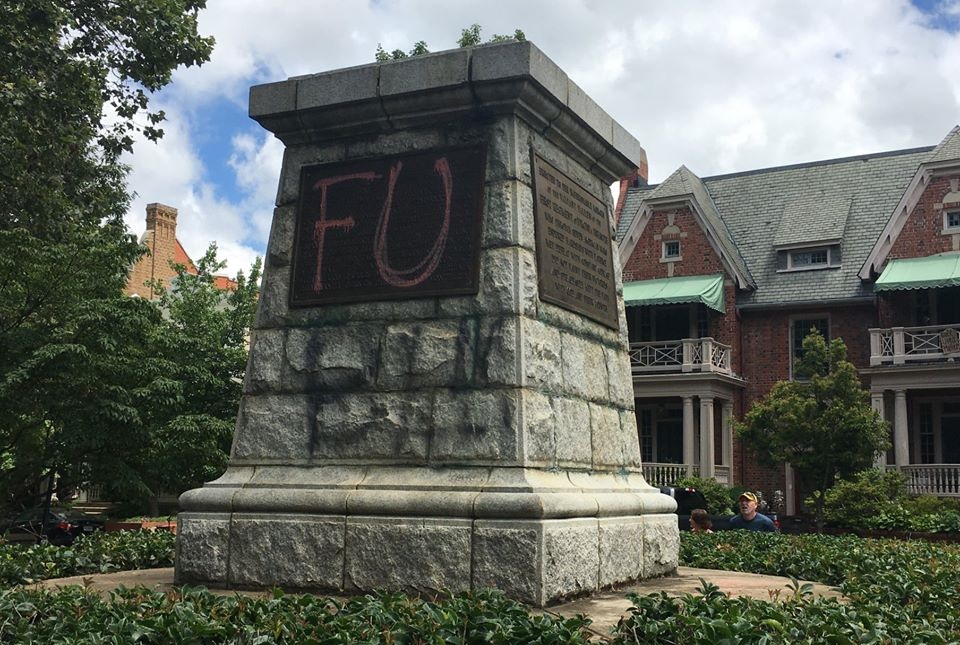No, but seriously — what was that monument in Meadow Park that protesters pulled down last month actually about? Was it a Confederate monument or not? We did some digging, and what we learned, well… it’s complicated.
Tucked between Park and Stuart Avenue, triangular-shaped Meadow Park now displays only the stone base of what once was a statue dedicated to the First Virginia Regiment. The fifth to be taken down by protestors, the statue was removed sometime during the night of June 19th and morning of the 20th.
With the statue gone, Richmond residents can now enjoy their picnic lunch from Garnett’s in the park without the presence of racist symbolism perched above their heads. Though, of course, if at any time one wishes to be reminded of this city’s dubious past, Marcus-David Peters Circle is just a two-block walk away.
In the wake of the statue’s removal, media reports explaining what the statue represented and who it was intended to valorize were unclear, sometimes going so far as to condemn protesters who, people alleged, had mistakenly removed a non-Confederate monument. But those allegations didn’t sit right with us here at RVA Mag, so we decided to dig deeper and find out what reasons protesters might have had for singling out the First Virginia Regiment as worthy of dethroning. And sure enough, we found a few.

To begin with, the First Virginia Regiment has a history dating back over 250 years. The unit was formed before the Revolutionary War, when the United States were still colonies of Great Britain. It was originally under the command of George Washington in 1754, and the regiment’s first battle against the French and other indigenous groups was in alliance with the Iroquois Confederacy. It lasted 15 minutes.
That battle occurred as part of what Americans know as the French and Indian War; in Canada and Europe, it’s known as the Seven Years War. In North America, it pitted the British and colonial forces against French colonial forces located in what are now the Canadian provinces of Quebec, Ontario, and New Brunswick.
After Washington took a French military officer as a prisoner of war, the Iroquian leader, known to his people as Half King, killed the officer without warning using a type of ax native to indigenous people.
According to the book Crucible of War: The Seven Years’ War and the Fate of Empire in British North America, the Half King had history with the French and the native people faced losing more land in the Ohio River Valley. Sold into slavery at a young age, he claimed that he and his father were kidnapped, his father boiled and eaten by the French.
The plaque on the monument to the First Virginia Regiment mentions Fort Necessity, where the regiment surrendered with Washington, in the only surrender of his military career. But the monument doesn’t just memorialize the original 237 men who fought for the regiment in the French and Indian War. It was commissioned to commemorate the regiment for participating in seven American wars, including the Civil War, when they fought alongside the Confederate Army.
Sculpted by Ferruccio Legnaioli and placed in the park on May 1, 1930, the statue’s remaining plaque now wears a spray-painted pink “FU” across its words. Underneath the graffiti, it reads: “Erected to the imperishable memory of the valiant fallen of the first regiment of Virginia infantry. Who through seven American wars endured hardships with patience, met defeat with constant courage, did not vaunt their victories, and steadfastly kept the faith with God and their country.”
Putting aside the obvious ignoring of America’s fundamental separation of church and state, the plaque has a few other issues as well. For starters, the original first regiment didn’t technically exist throughout all the wars they are referring to. The original regiment from 1754 that fought alongside George Washington and Joshua Fry is different from the First Regiment of Virginia Volunteers, which was created in 1846 to fight a war with Mexico and reorganized by the Confederate States Army at the beginning of the Civil War in 1861, according to Lee A. Wallace’s “The First Regiment of Virginia Volunteers, 1846-1848,” published by The Virginia Magazine of History and Biography in 1969.
The plaque continues, explaining that the regiment “joined the Confederate states to defend her honor and her sovereign rights. The First Regiment forthwith volunteered for duty.”

The First Virginia Volunteer Infantry Regiment fought with Kemper’s Brigade of Pickett’s division and the Army of Northern Virginia. It fought in Maryland and then at Gettysburg — which may mean it was part of Pickett’s Charge, the disastrous military maneuver that some consider a turning point in the Civil War — rejoining General Robert E. Lee before the confederacy’s surrender.
“In twenty-two engagements it gave of the best until, overwhelmed, it honorably laid down its worn arms at Appomattox Courthouse, April 9 1865,” the plaque reads.
After that, the First Virginia Regiment’s legacy seems to continue; the plaque on the monument notes their involvement in the Mexican Border War in 1916 and World War I. This brings us to the beginning of the era during which the statue was placed in Meadow Park. And leaves us with a question: Given that this statue seems to commemorate multiple military units with multiple names, which were reorganized multiple times over the course of 165 years, what does it really stand for?
“Reorganized after the peace of 1919, the regiment pledges its dead to preserve their ideals of duty,” the plaque concludes.
Whatever ideals the plaque alludes to didn’t seem worth preserving to the people of modern Richmond. And on June 19, they decided they weren’t going to wait for the city to agree with them.
All photos via Facebook



